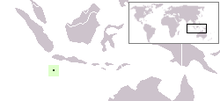Abbott's booby
| Abbott's booby | |
|---|---|
 |
|
| A juvenile | |
| Scientific classification | |
| Kingdom: | Animalia |
| Phylum: | Chordata |
| Subphylum: | Vertebrata |
| Class: | Aves |
| Order: | Suliformes |
| Family: | Sulidae |
| Genus: |
Papasula Olson & Warheit, 1988 |
| Species: | P. abbotti |
| Binomial name | |
|
Papasula abbotti (Ridgway, 1893) |
|
 |
|
| Christmas Island in green | |
| Synonyms | |
|
Sula abbotti (Ridgway, 1893) |
|
Sula abbotti (Ridgway, 1893)
Abbott's booby (Papasula abbotti) is an endangered seabird of the sulid family, which includes gannets and boobies. It is a large booby, smaller than gannets, and is placed within its own monotypic genus. It was first identified from a specimen collected by William Louis Abbott, who discovered it on Assumption Island in 1892.
Abbott's booby breeds only in a few spots on the Australian territory of Christmas Island in the eastern Indian Ocean, although it formerly had a much wider range. It has white plumage with black markings, and is adapted for long-distance flight. It forages around Christmas Island, often around nutrient-rich oceanic upwellings, although individuals can travel for thousands of kilometres. Pairs mate for life and raise one chick every two or three years, nesting near the top of emergent trees in the rainforest canopy.
The population is decreasing. Historically much of its former habitat was logged to make way for phosphate mining. Some logging continues, and the effects of the former logging continue to adversely affect the current population. Another threat has been caused by the introduction of yellow crazy ants, which decrease habitat quality. Minimal habitat declines have a significant effect on the bird population. All nesting areas have been included in a national park.
The first specimen was collected from Assumption Island in 1892 by American naturalist William Louis Abbott, northwest of Madagascar, although there is debate on whether he actually collected it from the nearby Glorioso Island. It was described by Robert Ridgway in 1893. In 1988 it was placed in its own genus by Olson & Warheit 1988. The basal characters present in this species suggest it may be an early branch of the sulid family, predating the split between gannets and other boobies. This was reinforced by analysis of the mitochondrial cytochrome b gene in 1997, which indicated Abbott's booby was an early offshoot of the gannets rather than the other boobies. However, 2011 study of multiple genes found it to be basal to all other gannets and boobies, and likely to have diverged from them around 22 million years ago.
...
Wikipedia

